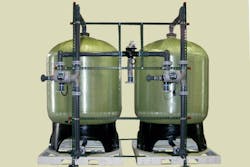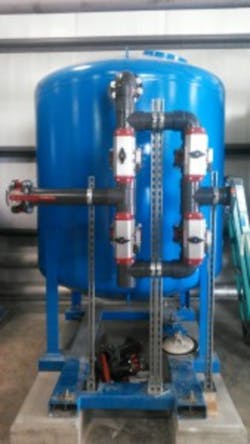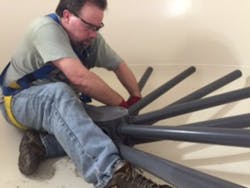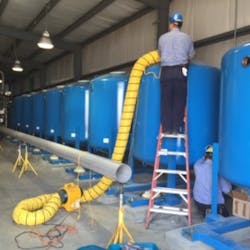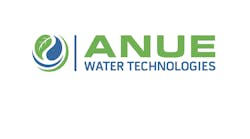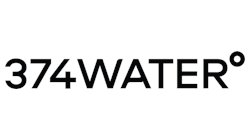One side of water quality management never considers grains per gallon. Soft water testing higher than 1 part per million (ppm) is unacceptable. In this world, if the filtration effluent tests in ppm, it is too much. A part per-billion unit of measure is the standard. Clients who require this miniscule quality level are trained technical professionals including chemists, engineers and scientists. Their idea of deionized water is measured in resistivity, not conductivity. If the water treatment system fails, alarms sound and production stops. The water manager triggers a corrective action report, and the clients require answers.
This world is not for the inexperienced, and the systems producing water in this arena are specialized, not off-the-shelf, equipment. These systems must be easily monitored, easily accessed (inside and out) and designed for fast, efficient service. This is the domain of steel tanks; programmable logic controllers (PLCs); and side-mounted, skid-mounted systems. This is a discipline involving many topics. This article looks at several components used to ensure water quality in the industrial arena and shares some reasons for their use.
Fiberglass
Fiberglass has its place in water conditioning. In residential, commercial and even light industrial applications, it is an adequate choice. The top-mount controls used on fiberglass vessels function well and many have efficient data collection and control options. If the controls are accessible from ground level and are adequate for the application, then they may be used when applicable. If the application is in an industrial facility, access to the controls becomes a managed concern.
The Occupational Safety Hazard Administration (OSHA) requires that full protection be provided at elevations of 4 feet in general industry workplaces.1 If the control is installed on top of a large tank, OSHA-approved protocols are required before any servicing activities begin. Standing on a ladder with no harness is not an option.
Side-mounted control valves
Many industrial end users require that instrumentation be accessible from ground level. If fiberglass is the material of choice for the application, the only option for compliance with the ground-level requirement is side-mounted controls (see Image 1). Some original equipment manufacturer (OEM) control valves have side-mounting options, allowing for a configuration to comply with elevated-workplace requirements. Side-mounted controls add to the complexity of the installation and require attention to load-bearing forces and material strength.
Image 2. Vessel and valve nest that accommodates filtration
Hanging a 3-inch OEM control valve from a fiberglass tank flange without sup-port is unacceptable. Side-mounted controls require supports, hangers, clamps and great attention to detail. In Image 1, the control valves and face piping require support. In this configuration, a strut frame supports the weight of the control valve and offers rigidity to the face piping. Pipe clamps hold the piping to the strut frame, and the tanks are mounted on skids per the client’s equipment protocol.
Valve nests
OEM control valves are often not the correct fit for many applications. Their pipe sizing may be too large for available OEM options and/or the client requires a specific valve type for the plant. In Image 2, the controls are 4-inch pneumatically operated butterfly valves. In this example, the plant uses this valve type because the personnel are already trained on its maintenance and repair. The plant uses this valve throughout the facility, allowing for the standardization of its spare parts inventory.
The system control in Image 2 is a valve nest, which will operate most systems, from ion exchange to filtration. The configuration varies with each application, but the principle of mounting valves on the exterior of the vessel for ease of operation remains the same. In an industrial setting, monitoring, service and functionality trump cost.
Image 3. A technician installs a two-tiered hub using 1 ¼-inch engineered laterals in a 72-inch diameter steel vessel.
Steel’s advantages
Steel tanks offer more strength than fiber-glass, so they can support more weight from external piping. This makes them an effective option for applications requiring face piping. Steel vessels have the option of multiple ports and openings located to suit the installation and requirements for customization.
The application in Image 2 requires 4-inch valves and piping to accommodate filtration. The side inlet flange offers a clean installation point, support for the valve nest and easy access to all controls. Using the side-mount flange and the strut supports allows the installer to align the bottom center outlet piping and valve.
Large industrial vessels require engineered distribution. Installing engineered hubs and laterals in large vessels is only possible by entering the tank through a manway. The size and shape of the man-way are dictated by the size of the tank dome. In Image 3, the technician is installing a two-tiered hub using 1 ¼-inch engineered laterals in a 72-inch diameter steel vessel. OSHA safety protocol requires that the technician use a harness and be attached to a safety line.
Image 4. A supervising technician monitors the activity to ensure OSHA compliance.
Image 4 shows the supervising technician as he monitors the activity and ensures that the ventilation blower and carbon dioxide monitor function in compliance with OSHA’s confined-space protocol. This is normal activity in an industrial facility.
Designing industrial systems requires the ability to create custom vessels and options for opening placement. Steel tanks are an excellent platform for customization. In addition, steel offers multiple materials of construction (including carbon steel and stainless steel), custom/special linings and exterior coatings. They are also easily skid-mounted.
Industrial end users often require media replacement because of the volume of water used and continuous service hours. Removing material from vessels and replacing it are more accommodating using manways and hand holes instead of removing control valves and unloading/loading around internal risers. Media replacement in larger vessels often necessitates the use of a vacuum truck. This service may be more difficult and precarious with fiberglass tanks.
Monitoring
The ability to monitor equipment and its operation is part of most industrial plants’ requirements for systems. While many OEM control valves have digital monitoring, diagnostics and data collection, they may not be compatible with a plant’s supervisory control and data acquisition (SCADA) systems. Many industrial systems providing process water to facilities operate with PLCs using platforms such as Allen Bradley, Mitsubishi or Siemens.
These control platforms allow personnel to monitor multiple operations at the same time and open valves to cycle systems. While performing these tasks, the PLC provides operators with the status of their water systems. Commonly, some systems process water at rates in the hundreds and thousands of gallons. One valve malfunction can send enormous volumes of water into the plant unexpectedly — creating major issues and shutdowns. This system information and application parameters appear on the controls and in the facility control room so operators can view all operation data in real time.
When designing equipment to support an industrial process or building a robust system, rules dictate the use of customizable control platforms, valve options and actuators, and vessels that meet the specifications of each application. Many companies specialize in supporting this market and provide effective and efficient systems. When an application requires a system that cannot use off-the-shelf products, consult with a custom-design-and-build contractor. Consider partnering with him or her to gain local business opportunities.
References
1. https://www.osha.gov/SLTC/fallprotection
Matthew Wirth is the general manager of Pargreen Water Technologies (an industrial system and service group based in Chicago) and a water professional with more than 34 years of experience. He is also a member of Water Technology’s Editorial Advisory Board. He holds a Bachelor of Arts in communication and organizations management from Concordia University in St. Paul, Minnesota, and received his engineering training at the South Dakota School of Mines and Technology in Rapid City, South Dakota. Wirth may be reached at [email protected] or 630-433-7760.
